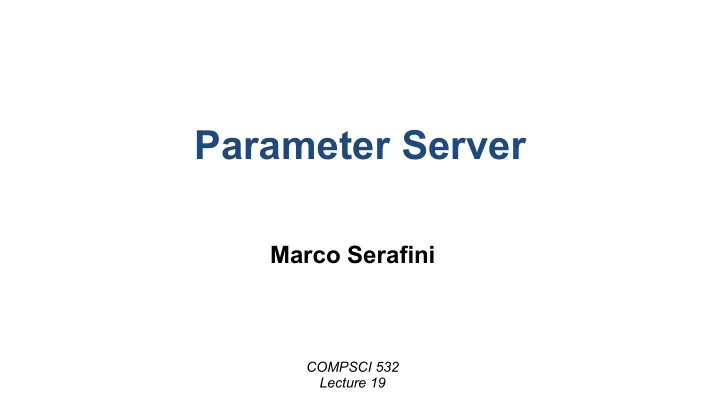

Parameter Server Marco Serafini COMPSCI 532 Lecture 19
Machine Learning • Wide array of problems and algorithms • Classification • Given labeled data points, predict label of new data point • Regression • Learn a function from some (x, y) pairs • Clustering • Group data points into “similar” clusters • Segmentation • Partition image into meaningful segments • Outlier detection 2 2
More Dimensions • Supervision: • Supervised ML: labeled ground truth is available • Unsupervised ML: no ground truth • Training vs. Inference • Training: obtain model from training data • Inference: actually run the prediction • Today we focus on the training problem 3 3
Example: Ad Click Predictor • Ad prediction problem • A user is browsing the web • Choose ad that maximizes the likelihood of a click • Training data • Trillions of ad-click log entries • Trillions of features per ad and user • Important to reduce running time of training • Want to retrain frequently • Reduce energy and resource utilization costs 4 4
Abstracting ML Algorithms • Can we find commonalities among ML algorithms? • This would allow finding • Common abstractions • Systems solutions to efficiently implement these abstractions • Some common aspects • We have a prediction model A • A should optimize some complex objective function L • E.g.: Likelihood of correctly labeling a new ad as “click” or “no-click” • ML algorithm does this by iteratively refining A 5 5
High-Level View • Notation • D: data • A: model parameters • L: function to optimize (e.g., minimize loss) • Goal: Update A based on D to optimize L • Typical approach: iterative convergence 𝐵 " = 𝐺(𝐵 "&' , ∆ * (𝐵 "&' , 𝐸) merge updates to parameters iteration t compute updates that minimize L 6 6
How to Parallelize? • How to execute the algorithm over a set of workers? • Data-parallel approach • Partition data D • All workers share the model parameters A • Model-parallel approach • Partition model parameters A • All workers process the same data D 7 7
How to Parallelize? • How to execute the algorithm over a set of workers? • Data-parallel approach • Partition data D • All workers share the model parameters A • Model-parallel approach • Partition model parameters A • All workers process the same data D 8 8
Data-Parallel Approach 𝐵 " = 𝐵 "&' + Σ /0' ∆(𝐵 "&' , 𝐸 / ) 1 • Process for each worker • Update parameters based on data • Push updates to parameter servers • Servers aggregate & apply updates • Pull parameters • Requirements • Updates associative and commutative! • Example: Stochastic Gradient Descent 10 10
Example • Each worker • Loads a partition of data • At every iteration, compute gradients • Server • Aggregate gradients • Update parameters 11 11
Parameter Server • Stores model parameters • Advantages • No need for message passing • Distributed shared memory abstraction • Very first implementation: key-value store • Improvements by the work we read • Server-side UDFs • Worker scheduling • Bandwidth optimizations 12 12
Architecture • Different namespaces • Single parameters as <key, value> pairs • Server-side linear algebra operations • Sum • Multiplication • 2-norm 13 13
Does This Scale? • We said that a model can have trillion parameters • Q: Does this scale? • A: Yes • Each data point (worker) only updates few parameters • Example: Sparse Logistic Regression 14 14
Optimizing communication • Machine learning is communication-heavy • Ranges • Workers do not update single keys • Instead they batch updates per range • Message compression • Worker-side caching of lists + send hash of lists • Don’t send zeroes • Snappy compression • Filtering: small updates are omitted (application-specific) 15 15
Tasks • Activated by RPC: push or pull operations • Executed asynchronously • Users can specify the dependency of tasks 16 16
Flexible Consistency • Typical semantics • Sequential • Eventual • Bounded delay 17 17
Dependencies • Vector clocks to express dependencies • Size: one entry per parameter per node is too large • Use instead one entry per range per node • Ranges are few and not split frequently 18 18
Consistent Hashing • Server manager maintains the ring • Other servers receive ranges 19 19
Replication • Synchronous replication • Master pushes aggregated updates • When all replicas receive update, ack • Replication after aggregation • Master waits until multiple updates are ready 20 20
Results: Sparse Logistic Regression • Convergence and CPU utilization 21 21
Effect of Network Compression 22 22
Effect of Asynchrony • Note: More asynchrony not always better 23 23
How to Parallelize? • How to execute the algorithm over a set of workers? • Data-parallel approach • Partition data D • All workers share the model parameters A • Model-parallel approach • Partition model parameters A • All workers process the same data D 24 24
Model-Parallel Approach "&' 𝐵 "&' , 𝐸)} /0' 𝐵 " = 𝐵 "&' + 𝐷𝑝𝑜 ({∆ / (𝐵 "&' , 𝑇 / 1 ) • Process for each worker "&' to update (from scheduler) • Receive ids of parameters 𝑇 / • This is a partition of the entire space of parameters • Compute update on those parameters • Send updates to parameter server that • Concatenates updates (which are disjoint ) • Applies updates to parameters • Requirements • There should be no/weak correlation among parameters • Example: matrix factorization • Q: Advantage? 26 26
Model-Parallel Scheduler • Some systems (e.g. Petuum) support global scheduler • Scheduler runs application-specific logic • Two main goals • Partition parameters • Prioritized scheduling: give precedence to parameters that converge slower 27 27
28
Horovod • Use a ring topology among workers for aggregation • Linear instead of quadratic number of messages • Schedule non-overlapping updates Workers … … Workers Parameter servers 29 29
Scheduling Updates 30 30
Recommend
More recommend